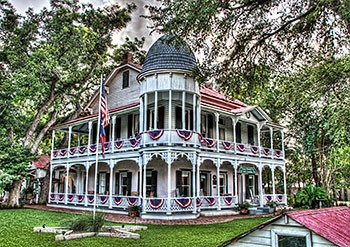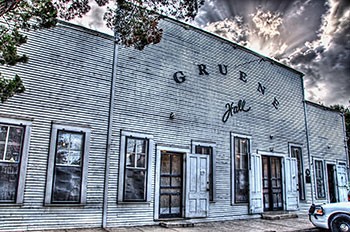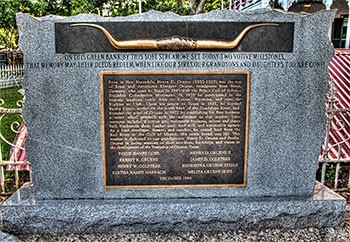The Gruene Historic District and New Braunfels area attract millions of visitors each year. Not a bad legacy for a dusty cowboy once covered in lice.
Yet the story of two-time trail rider Heinrich “Henry” D. Gruene (pronounced “green”), in whose honor The Gruene Cowboy is named, all but faded into obscurity after his death in 1920.
His proud little town followed soon after. Boll weevil killed cotton, the Depression killed the economy, and highways built for cars instead of stage coaches bypassed Gruene altogether.
The little town named after a cowboy withered away into another well-worn western trope—a ghost town.
Gruene was rescued from near-oblivion by Chip Kaufman, an architecture student at University of Texas-Austin. Kaufman spotted the ruins of this once-proud cotton town while kayaking down the Guadalupe River in 1974.
The story of how Kaufman, Pat Molak and Mary Jane Nalley worked with far-sighted developers to rebuild Gruene, save its water tower and restore Gruene Hall—the oldest continuously operating dance hall in the State of Texas—is well known.
But who was the Henry Gruene, the cowboy and man behind one of the most famous tourist destinations in Texas?
The Gruene Cowboy
Henry Gruene, aka The Gruene Cowboy, was the second son of German immigrants Ernst and Antoinette Gruene, who arrived in the new city of New Braunfels in 1846. They immigrated through Adelsverein, the Society for the Protection of German Immigration. Henry Gruene was born in New Braunfels in 1850. Siblings included older brother Ernst Jr. and a sister, Joanna.
Land in New Braunfels was scarce, so Ernst Gruene purchased land along the Guadalupe River, some four miles northeast of New Braunfels.
Nineteen-year-old Henry Gruene left the family farm in the spring of 1870 after William Murchison, a friend living along the Colorado River, invited him to join a trail ride to Kansas. Gruene asked his father for his blessing before departing for Llano, Texas, to gather cattle for the long drive north. Gruene's salary was $30/month.
His inaugural trip up the trail was fraught with stampedes and bad weather. The biggest surprise, however, was arriving in Abilene, Kansas only to be told the cattle needed to be driven all the way to Cheyenne, Wyoming instead.
The True Spirit of Texas
All of the “Texas boys” except Gruene quit immediately. The Gruene Cowboy stayed with the herd, only to arrive in Cheyenne to discover the buyer now wanted the cattle delivered to Bear River, 110 miles north of Salt Lake City.
The soon-to-be-legendary businessman negotiated a salary of $60 per month and an agreement he would not have to work the rear—and very dusty part—of the herd.
The trip across the Rockies was treacherous. Gruene credited his survival to burning sagebrush throughout the long, freezing nights.
After receiving his wages in twenty-dollar gold pieces and de-lousing himself in Salt Lake City, Gruene took a train to Abilene, Kansas then bought a horse and rode to Baxter Springs, Missouri. To make it all the way back to Texas, he hired on as a cook with a wagon train headed south for Hays County, Texas.
The Gruene Cowboy returned to the cattle trails in 1871, driving 335 of his own cattle north with other “beeves” owned by William Green. When he reached Kansas City, the price of cattle had fallen and the livestock was sold on credit. His creditor went broke, and the young cowboy lost all of his money.
The Gruene Mansion Inn

Henry Gruene returned to the little town then known as Goodwin, disillusioned by the experiences he describes in The Gruene Cowboy. Soon after his arrival, he married Bertha Simon and built a home, known by tourists today as The Gruene Mansion Inn.
Out of the saddle Gruene proved to be a visionary and, like more than a few of his fellow trail riders, a very shrewd businessman.
Cotton was ascendant following its arrival in New Braunfels in 1852. By the time Henry Gruene quit the trails almost 20 years later, it was New Braunfels’ number-one cash crop.
The Gruene Cowboy knew his land was fertile enough to support a viable cotton-farming operation. In 1873, he bought out his brother’s interest in the family land, advertised for sharecroppers and attracted between 20 to 30 families to Goodwin/Gruene. Each sharecropper was granted between 100 to 200 acres.
His first business venture was a water-wheel grist mill. A cotton gin followed, along with other necessities like a saloon.
To support his cotton operation’s burgeoning population, in 1878 Henry Gruene built a mercantile store along the stagecoach route from San Antonio to Austin. Sometimes on credit (debt to be settled at harvest time with either cash or vegetables and crops), he sold food, canned goods, farming implements and hardware supplies. Also available were refreshments for passengers on the Brown Tarbox stagecoach line.
To educate sharecroppers’ children, Gruene built Thorn Hill School in 1874. A second school followed in 1893.
Gruene Dance Hall

Gruene Hall, one of the oldest continuously functioning dance halls in Texas.
Gruene’s cotton gin, powered by the Guadalupe River, soon processed raw cotton from around the county. To facilitate growth, he also built a lumber yard to mill and sell long-leaf pine needed to build barns and houses for tenant farmers.
By 1890, almost 8,000 acres of land east of the Guadalupe were planted with cotton and other crops.
In the 1880s, International and Great Northern Railroad added a freight and passenger depot just to the west of Goodwin. The Missouri, Kansas & Texas railroad built another in 1901. The rails allowed Henry Gruene to export cotton and grain, and ship goods in for his mercantile. In 1904 he built a new store that also served as a working bank, holding farm mortgages and providing extensive farm financing.
Henry Gruene also became postmaster for his community, which was renamed Gruene (pronounced “Green”) in 1903 after U.S. mail rural free delivery began. He worked in partnership with sons Max and Othmar.
According to a Comal County website, “The name was most appropriate for the economic system as the whole life of the town rotated around the Gruene family.”
Henry Gruene retired in 1910, leaving his sons to manage his estate. His daughters, Mrs. Fritz Hampe and Mrs. Ella Ogletree and their families lived in Gruene, close to their father. His parents also moved to Gruene from Comaltown, dying in 1914 and 1917.
Largest Landholder
By now, The Gruene Cowboy was one of the largest landholders in Comal County. In 1916, he worked with a surveyor on a preliminary project to draw the town into lots and streets.
However, his luck soon ran out. In 1918 the Spanish Influenza raged throughout the United States, killing Max Gruene. Henry discovered he had cancer. He crossed "the Great Divide" in 1920 while undergoing treatment at the Mayo Clinic in Rochester, Minnesota. The cause of death was pneumonia.
In 1984, grandchildren Bessie Hampe Cobb, Ernest K. Gruene, Henry W. Ogletree, Bertha Hampe Marbach, Henry D. Gruene II, James D. Ogletree, Henrietta Gruene Steele and Melita Gruene Hope dedicated a small monument to H.D. in front of his old home. It reads:
“Born in New Braunfels, Henry D. Gruene (1850-1920) was the son of Ernst and Antoinette Kloepper Gruene, immigrants from Netze, Germany, who came to Texas in 1845 with the Prince Carl of Solms-Braunfels Colonization Movement. In 1870 he participated in the historic longhorn cattle drive to Kansas, Wyoming, and over the Rockies to Utah. Upon his return to Texas in 1871, he married Bertha Simon, settled on the north bank of the Guadalupe River, and founded the town of Gruene in 1872 by establishing his first business, a water wheel gristmill with the millstones at this marker. Later ventures included a cotton gin, mercantile business, saloon and dance hall, blacksmith shop, lumber yard, feed mill, and automobile agency. As a land developer, farmer, and rancher, he owned land from the Red River to the Gulf of Mexico. His cattle brand was HG. This marker is dedicated to our grandparents, Henry D. Gruene and Bertha Gruene in loving memory of their sacrifices, hardships, and vision in the development of the Township of Gruene, Texas."
Gruene’s Legacy
Gruene built a successful, thriving town. He was visionary businessman who turned the wilderness surrounding the banks of the Guadalupe River into a hugely profitable cotton-growing business. What he envisioned as a center of agricultural commerce today is a profitable tourist destination celebrating the bucolic early days of Central Texas.
Answering George W. Saunders’ call for early accounts of the cattle trail, Gruene described life in 1915-1920 Gruene: “We have prospered and are living very contented. I am in the mercantile business and handle lumber and implements as well, besides having a cotton gin, and own some good farms. We have four children, two boys and two girls, and they are all right here with me helping to conduct my business.
“Our place is better known as Gruene’s, and any time any of my old friends come this way I will appreciate a visit.”
Millions do each year.

